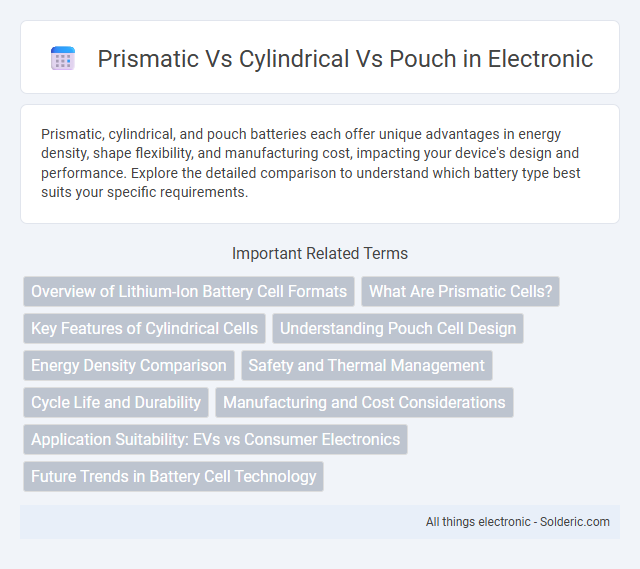Prismatic, cylindrical, and pouch batteries each offer unique advantages in energy density, shape flexibility, and manufacturing cost, impacting your device's design and performance. Explore the detailed comparison to understand which battery type best suits your specific requirements.
Comparison Table
| Feature | Prismatic Battery | Cylindrical Battery | Pouch Battery |
|---|---|---|---|
| Shape | Rectangular, flat cells | Round, cylindrical cells | Flexible, flat pouch cells |
| Energy Density | High volumetric efficiency | Moderate energy density | Highest energy density |
| Weight | Moderate weight | Heavier due to metal casing | Lightweight, minimal casing |
| Thermal Management | Good heat dissipation | Excellent heat dissipation | Challenging heat management |
| Manufacturing Cost | Higher cost due to complex design | Lower cost, standardized production | Moderate cost, labor-intensive assembly |
| Durability | Rigid structure, robust | Durable and pressure resistant | Less durable, prone to swelling |
| Applications | Electric vehicles, consumer electronics | Power tools, laptops, e-bikes | Smartphones, wearables, EVs |
Overview of Lithium-Ion Battery Cell Formats
Lithium-ion battery cells are primarily available in prismatic, cylindrical, and pouch formats, each offering unique structural advantages for energy density and thermal management. Prismatic cells feature a rectangular, rigid casing ideal for space optimization in electric vehicles and portable electronics, while cylindrical cells utilize a robust metal can design known for excellent mechanical stability and cost-effectiveness. Pouch cells distinguish themselves with a flexible, lightweight foil packaging that enables high energy density and customizable shapes, widely used in consumer electronics and electric mobility applications.
What Are Prismatic Cells?
Prismatic cells are a type of rechargeable lithium-ion battery characterized by their rectangular, flat shape, which allows for efficient use of space and easier assembly in battery packs. Unlike cylindrical cells that have a round shape and pouch cells that use a flexible foil casing, prismatic cells offer a rigid metal casing that provides enhanced mechanical stability and improved thermal management. Your choice of battery type depends on the specific application needs, with prismatic cells often favored in electric vehicles and large-scale energy storage due to their high energy density and structural strength.
Key Features of Cylindrical Cells
Cylindrical cells feature a robust metal casing that enhances durability and thermal management, making them ideal for high-drain applications and efficient heat dissipation. Their standardized shapes allow for easy stacking and integration in battery packs, contributing to scalable energy density and consistent performance. These cells typically offer higher cycle life and are cost-effective due to mass production techniques widely adopted in industries like electric vehicles and power tools.
Understanding Pouch Cell Design
Pouch cell design offers flexibility and lightweight advantages compared to prismatic and cylindrical batteries, enabling higher energy density through efficient space utilization and reduced packaging mass. Its laminate structure allows for customized sizes and shapes, making it ideal for compact electronic devices and electric vehicles requiring optimized form factors. The absence of rigid casing in pouch cells enhances thermal management and safety, contributing to improved overall battery performance.
Energy Density Comparison
Prismatic batteries typically offer higher energy density than cylindrical cells due to their optimized shape, which allows more active material in a smaller volume, resulting in better space utilization for electric vehicles and portable electronics. Cylindrical cells provide reliable performance with moderate energy density but excel in thermal management and mechanical stability, making them ideal for high-drain applications. Pouch cells deliver the highest energy density per weight because of their flexible packaging and reduced casing materials, enabling lightweight designs crucial for drones and mobile devices.
Safety and Thermal Management
Prismatic batteries offer enhanced safety features due to their rigid casing that reduces swelling and improves structural stability during thermal events, while cylindrical cells provide better heat dissipation because of their uniform shape, facilitating efficient thermal management. Pouch cells, despite being lightweight and flexible, require advanced thermal management systems to prevent overheating and potential swelling, increasing the complexity of safety measures. Your choice should consider the balance between structural integrity and effective heat dispersion for optimal battery performance and safety.
Cycle Life and Durability
Prismatic batteries offer robust cycle life and enhanced durability due to their rigid casing, making them ideal for applications requiring long-term reliability. Cylindrical cells provide excellent durability through uniform pressure distribution and efficient thermal management, often resulting in higher cycle counts compared to pouch cells. Pouch batteries deliver lightweight designs and flexible form factors but typically have shorter cycle life and require careful handling to prevent swelling and damage, affecting overall durability.
Manufacturing and Cost Considerations
Prismatic batteries offer efficient manufacturing with standardized shapes that simplify assembly but tend to incur higher costs due to complex casing materials. Cylindrical cells benefit from mass production techniques, leading to lower unit costs and increased durability, yet their rigid form can limit design flexibility. Pouch cells provide lightweight, customizable packaging that reduces material use and manufacturing time but require advanced sealing processes, often increasing production expenses.
Application Suitability: EVs vs Consumer Electronics
Prismatic batteries offer a compact design and high energy density, making them ideal for electric vehicles (EVs) where space efficiency and longer range are crucial. Cylindrical batteries provide excellent thermal management and durability, often preferred in consumer electronics for reliable performance and ease of mass production. Pouch batteries deliver lightweight flexibility and customizable shapes, suitable for both EVs and consumer electronics, especially where weight reduction and design adaptability are critical.
Future Trends in Battery Cell Technology
Future trends in battery cell technology emphasize the evolution of prismatic, cylindrical, and pouch cells, each offering unique advantages in energy density, thermal management, and manufacturability. Prismatic cells are advancing with higher capacity and better space utilization, cylindrical cells are improving in fast-charging and safety features, while pouch cells lead in flexibility and lightweight design ideal for electric vehicles and portable devices. Understanding these trends can help you choose the optimal battery type for future-proof energy storage solutions.
Prismatic vs Cylindrical vs Pouch Infographic

 solderic.com
solderic.com